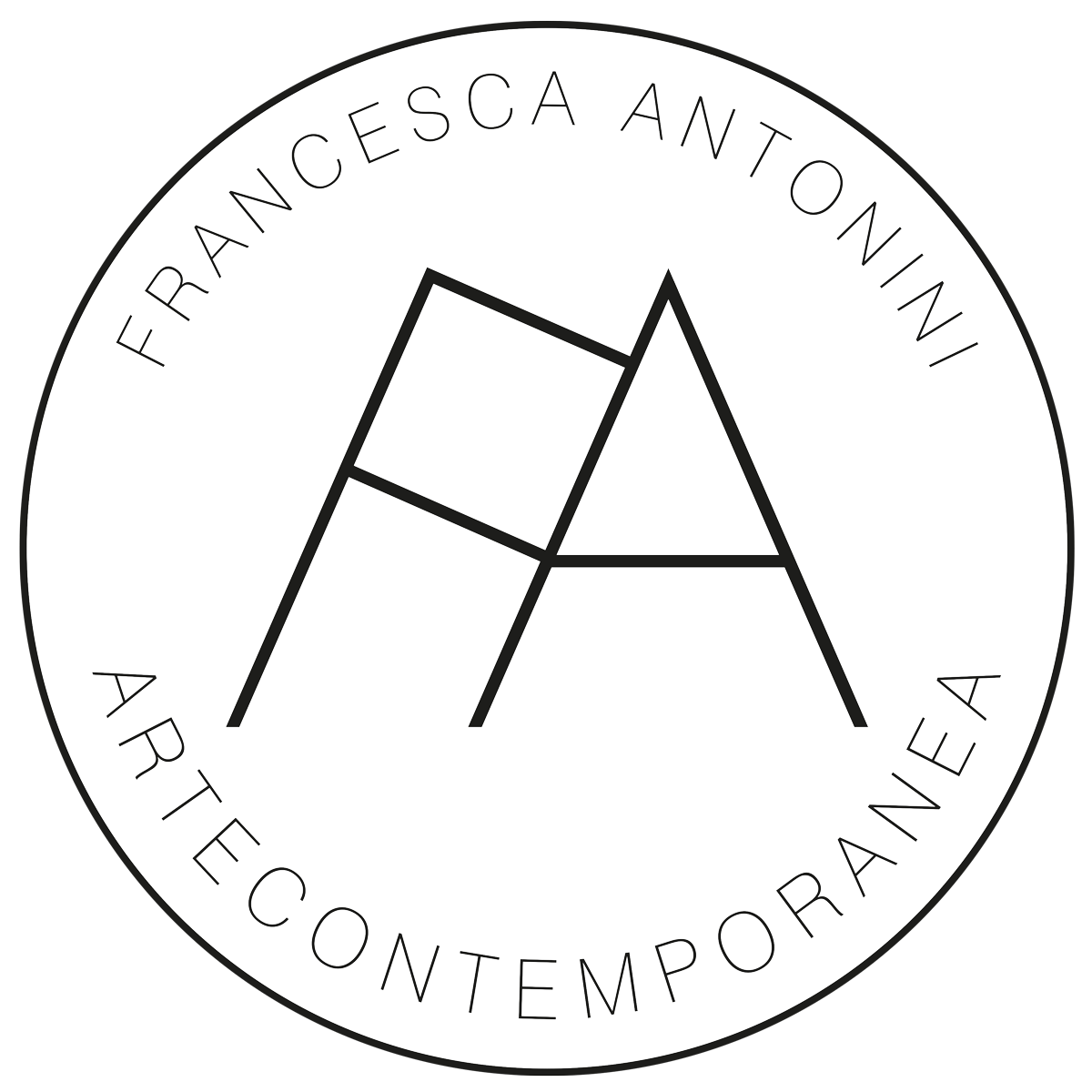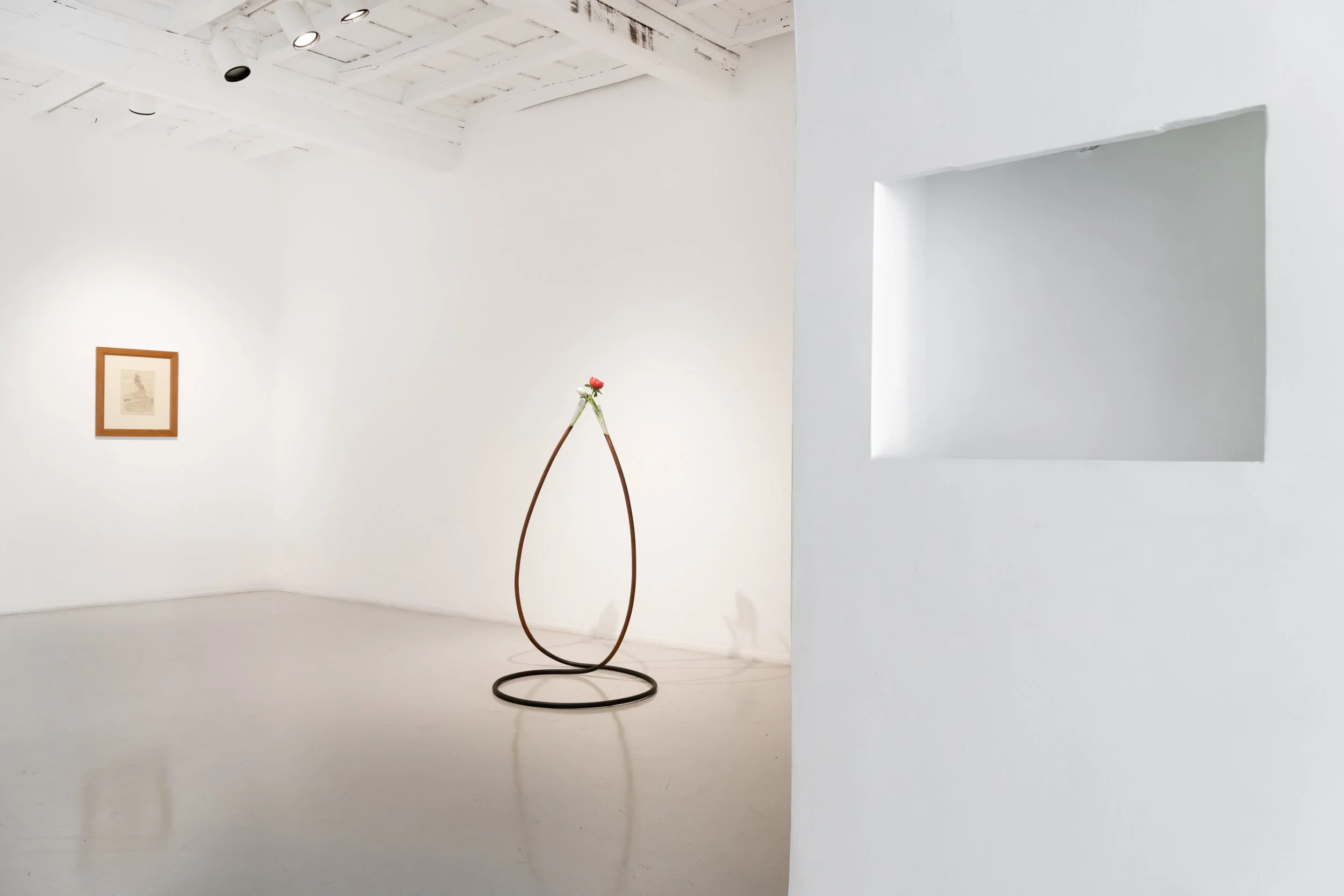LA TEMPESTA NEL BICCHIERE
MARIO AIRò, GREGORIO BOTTA, DANIELE DI GIROLAMO, BEATRICE PEDICONI, ALBERTO SAVINIO
OPENING tuesday maY 6th 2025
until friday SEpTEMBer 12nd 2025
LA TEMPESTA NEL BICCHIERE
SAVERIO VERINI
The most poignant place in Rome is probably the tomb of the poet John Keats, at the Non-Catholic Cemetery. On the headstone, near the end, one can read these words:
“Here lies One
Whose Name was written in Water.”
“Here lies one whose name was written in water.” There is no reference at all, only the eloquent titling - a few lines above - to an unspecified “young English poet”, which precisely due to such unusual and ostentatious vagueness has, over time, become an unequivocal certification of Keats' own identity. Writing in water is perhaps one of the images that can best express the essence of the artistic gesture, at least from a Romantic perspective: there is the yearning for the end of things, a certain poetic delicacy, the seeming futility of something that is destined to vanish irretrievably. It is difficult for me to think of more exact words than Keats' epitaph to describe the sentiment of La tempesta nel bicchiere (words that were immediately shared with Francesca Antonini when I received the invitation to curate a small exhibition starting from the theme of water). As we remember, right from the start there was the question of circumscribing a topic that is fluid, capable of taking infinite forms and rivulets, potentially expanding out of all proportion. On the other hand, water is a primal element of the universal order, capable of uniting founding myths and cosmogonies from the most diverse cultures; it is, moreover, a constant presence in the history of images because of its countless symbolic references. To how many paintings has it served as a backdrop and of how many others has it been the main subject? How many artists today are inspired by its less limpid side, shipwrecks at sea, water pollution, global warming?
In this circumstance, we preferred to focus on a more specific point of view. Not Hokusai's scratchy waves, nor scenes of nautical battles or tragic sinkings à la Gericault, not even the “mappings” of the Mediterranean made by the Forensic Oceanography group, documenting the distressing trajectories of migrant boats; water is represented here not in its sublime aspect of expanding force - irrepressible and impetuous -, but in its character as a “gentle” and circumscribable liquid. The works in the exhibition suggest containment rather than overflow: uniting them is a subtle sense of proportion, thanks to a use of water that does not involve getting of the edge.
Daniele Di Girolamo (Pescara, 1995), who welcomes visitors at the entrance, recreates a measured sound of water. The artist's poetics is oriented toward giving a body to ephemeral and intangible phenomena: in this case, the constant movement of a wave, which introduces the exhibition through a sound. Sound that, as it often happens in Di Girolamo's works, becomes image: the rotating cylinders on the wall with sand inside become unexpected amplifiers, which give the sound of the undertow a peculiar plasticity (it is curious, to evoke water is used an element “opposite” to it as sand). A Measure of Distance I (2) is the skin that covers an acoustic phenomenon of which each person has experienced, thus triggering a constellation of memories and associations, with all their gaps, alterations, blurs.
Chi non ha mai sentito la pioggia, ride delle ninfee (Paul Eluard) is the elegiac title of the work of Beatrice Pediconi (Rome, 1972). For some years now, the artist has been developing a particular technique that holds painting and photography together: the lines that run through her monochrome canvases are, in fact, filaments of emulsion taken from scraps of old Polaroids, which are transferred to the support, adhering to it, during a process that takes place entirely in water. The images that result from this bathing - but I would almost say “baptism” - resemble ghostly flowers; floating and ethereal, they adhere like a skin to the canvas, thus finding a miraculous, delicate embodiment. Pediconi's invention closely recalls the “writing in water” of Keats's tombstone, with which it also shares a memorial value: the stems and petals that take body on the canvas derive from the artist's previous works, which - thanks to a strange form of metempsychosis - find new life in this way.
Talking about flowers, Untitled by Mario Airò (Pavia, 1961) features a peony and a tulip, obviously immersed in water contained in two very long, tapered copper and glass vases. Undoubtedly, Airò is among the artists of the contemporary art scene who has best shaped works fueled by unprecedented grace. His works - the one in the exhibition is a paradigmatic example of this - stand on a millimetric balance, between precariousness and completeness, dreamlike dimension and concreteness, without ever falling into complacent patheticism. In front of his works, I am often crossed by a frisson: although aesthetically pleasing, their ambiguous constitution seems to suggest a sense of panic, as if a breath is enough to compromise their stability, jeopardize their safety. Observing the sculpture, one can see how the vases with flowers are actually connected, as if they were the two heads of a single serpentine body that twists on itself, generating an intimate, harmonious, romantic embrace.
For Gregorio Botta (Naples, 1953), water is to all intents and purposes a material from which to shape his own works. Water, in Botta, seems to me to call into question an almost liturgical dimension. This, at least, seems to be the case with Muta, the work in the exhibition. Indeed, ever since I first encountered them at MACRO in 2012, I have always felt that Botta's works emanated a sacred aura: they are refuges (this was, not coincidentally, the title of the exhibition at MACRO), secluded places (perhaps this is why they are often set up near walls, as if seeking protection); sometimes brighter and clearer, sometimes more opaque, his works make me think of the cells of a miniature hermit, spaces of concentration and recollection animated by a frugal solemnity. Muta proposes the image of suspension, an inertia that - behind the enchanted levitation - underlies a subtle tension that defies the principles of physics. The height of the bronze bowl exceeds the average height of the observer's eyes: the contents thus remain concealed, feeding the mystery of that metaphysical buoyancy.
The last work in order of appearance is the first to have somehow inspired the exhibition. It is a drawing from the 1940s by Alberto Savinio (Athens, 1891 - Rome, 1952), with the rather articulate title, Turbine o storia vera - La nostra nave fu innalzata da un turbine. It frequently happens that figures in Savinio's paintings and drawings float suspended over seascapes; in this case it is a ship that is propelled aloft, lifted by the swirling motion of the waves. As in Botta's work, here too we are faced with an elevation that has something magical about it: the ship seems to be carried in triumph by the waters, which are rendered through a synthetic stroke, a soft and controlled “calligraphy.” Rather than a shipwreck, we witness a miraculous event, a small episode in that fragmentary and at times nostalgic mythology that runs through much of Savinio's production.
This is perhaps the image that can best condense the exhibition and “explain” its title. An exhibition made of movements, vibrations and ripples, which, however, do not crack the work's bank. If we could make an unfulfillable wish - both because of the impossibility of obtaining the loan and because of the size of the work - 32 metri quadri di mare circa Pino Pascali would be part of this itinerary, or at least we like to think so, because of its ability to hold together energy and containment, expansion and measure. It is under the banner of this balance that we have tried to imagine La tempesta nel bicchiere.
PRESS REVIEW

















